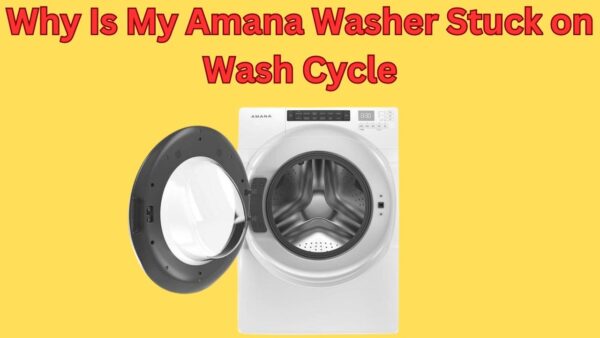When a washing machine refuses to agitate but willingly spins and drains, it can be a perplexing issue.
This guide will help you understand the 15 most common reasons behind this specific malfunction and provide practical solutions to each.
The intent is to empower you to troubleshoot and possibly resolve the issue, saving you the time and expense of a service call.
Washing Machine Will Not Agitate but Will Spin and Drain

1. Faulty Drive Belt
Cause
The drive belt, which connects the motor to the agitator, enables your washing machine to agitate. If the drive belt is damaged or worn out, the machine may spin and drain, but it will not agitate.
Signs of a faulty drive belt include excessive noise during the agitation cycle and visible wear or damage upon inspection.
Look for clues such as squeaking sounds or a belt that seems too loose or too tight. If you notice these signs, it’s likely that the drive belt is the culprit.
Solution
Fixing a faulty drive belt usually involves replacement rather than repair. Unplug the washing machine, remove the back panel, and locate the drive belt.
If it shows signs of wear or damage, purchase a new one and replace it. Ensure that the new belt is correctly aligned with the motor and the agitator pulleys to ensure optimal performance.
Always consult your washing machine’s user manual or a professional if you’re unsure.
2. Damaged Agitator Components
Cause
The agitator components, including the agitator cogs, agitator cap, and drive block, play a significant role in your washing machine’s operation.
If these parts are damaged, worn out, or broken, the machine may fail to agitate properly, although it will still spin and drain.
Faulty agitator components manifest as an unusual noise or movement during the wash cycle, or the machine may not move at all.
Solution
To rectify this issue, you will need to inspect the agitator components. Begin by removing the agitator cap and inspecting the cogs.
If they are worn out or broken, you will need to replace them. Similarly, check the drive block located on top of the agitator. If it’s damaged, you will need to replace the drive block.
Note that while you can carry out these repairs yourself, you may need to hire a professional if you’re unfamiliar with the process, as improper repairs can lead to further damage.
3. Worn Out Motor Coupling
Cause
The motor coupling joins the motor and the transmission. A worn-out motor coupling can prevent the washing machine from agitating while allowing it to spin and drain.
This is often due to excessive use or overload, causing the plastic or rubber components of the coupling to wear out or break.
Solution
The solution is straightforward: The faulty motor coupling must be replaced. You can accomplish this by disconnecting the washing machine from the power source, removing the cabinet, and replacing the worn-out coupling with a new one.
It’s crucial to make sure that the new motor coupling is compatible with your washing machine model.
Always remember, that safety comes first, so if you’re not confident in your abilities to do this safely, hiring a professional is the best course of action.
4. Malfunctioning Drive Motor
Cause
The drive motor is responsible for turning the agitator during the wash cycle. If your washing machine is not agitating but still spinning and draining, a faulty drive motor could be the cause.
Over time, the motor can wear out or become overloaded and stop functioning correctly.
The drive motor is integral to the machine’s operation, and if it malfunctions, the washing machine might not agitate as needed.
Solution
The solution to a malfunctioning drive motor is typically a replacement. It is recommended to call a professional technician for this task as it requires specific tools and knowledge.
If your washing machine is still under warranty, the replacement may be covered.
Available DIY tutorials may guide you through the replacement process, but it’s often safer and more efficient to hire a professional.
Don’t forget to check the machine’s warranty before proceeding with any solution.
5. Broken Lid Switch
Cause
The lid switch on a washing machine is a safety feature designed to prevent the motor circuit from operating when the lid is open.
If this switch is broken, it may cause the machine to stop agitating. This can occur due to wear and tear or from the excess weight of heavy loads.
Solution
To fix a broken lid switch, you will need to replace it with a new one. It’s recommended that you purchase the replacement part from a reputable supplier to ensure compatibility with your washing machine model.
You can refer to your appliance’s user manual for detailed instructions on how to replace the lid switch.
If you’re not comfortable doing this yourself, it’s recommended to hire a professional to ensure the job is done correctly and safely.
6. Ineffective Agitator Dogs
Cause
Sometimes, the agitator dogs in your washing machine can become worn out, leading to ineffective agitation.
These small but crucial components are responsible for the top half of the agitator function. In their absence, you may observe that the bottom part of the agitator is working but the top is just idly moving in circles.
A clear sign of ineffective agitator dogs is when your clothes come out less clean than usual.
Solution
The standard solution to ineffective agitator dogs is to replace them. Fortunately, they are relatively inexpensive and easy to replace.
You can find them at any appliance parts store or online. Make sure to refer to your washing machine’s model number to get the correct part.
Usually, the process involves removing the fabric softener dispenser and the agitator cap to access the agitator dogs.
Always remember to disconnect the washing machine from the power source before attempting any repairs.
7. Broken Timer Dial Skirt
Cause
The Timer Dial Skirt, also known as the control dial, is critical for setting your washing machine’s cycles. If this component is broken, it may prevent your washer from agitating.
This usually happens over time due to wear and tear, or because of overuse.
The key signs of a broken timer dial skirt include an inability to set the machine’s cycles properly, or the dial not turning or sticking in one position.
Solution
The most effective solution is to replace the broken timer dial skirt. This process involves removing the control panel, detaching the old dial, and installing a new one.
It’s advisable to consult your washing machine’s manual or hire a professional to avoid causing further damage.
Remember, using original, high-quality replacement parts can significantly increase the lifespan of your washing machine. Always disconnect the power before you start any repair.
8. Faulty Washer Electronic Control Board
Cause
The washer’s electronic control board manages the washer’s cycles, such as fill, wash, drain, and spin. If the board is faulty, it may not send the necessary signals to initiate these tasks, which could result in the washer not agitating.
Common signs of a faulty control board are inconsistent or erratic behaviors of the machine that are not tied to specific cycles.
A faulty control board might make the washer behave inconsistently. Control boards are responsible for every cycle in a machine.
Erratic behaviors of a machine are huge indicators of control board issues.
Solution
To resolve this, the electronic control board must be replaced. This task is moderately challenging and may require professional help.
Ensure you have the correct replacement part by checking the model number of your washer. Always remember to disconnect the washer from the power supply before attempting any repairs.
Replacing the faulty control board is the solution. Professional help may be required due to the task’s complexity.
Always disconnect power before attempting repairs. Ensure the replacement part matches your washer’s model number.
9. Damaged Drive Block
Cause
The drive block is a crucial part of the agitator assembly in a washing machine. This component is responsible for connecting the inner tub to the transmission, allowing the tub to agitate.
If the drive block is damaged or worn out, it prevents the efficient movement of the agitator, resulting in the washer not agitating despite spinning and draining normally.
Common signs of a damaged drive block include the washer not agitating properly and a rattling sound during the wash cycle.
Solution
The solution to a damaged drive block is to replace it with a new one. To do this, you’ll need to dismantle the agitator assembly, remove the old drive block, and install the new one.
This task can be moderately difficult depending on your familiarity with appliance repair and may require professional assistance.
Always disconnect the washer from the power source before carrying out any repairs. Ensure that the replacement drive block is suitable for your particular washer model.
10. Failed Agitator Repair Kit
Cause
The agitator repair kit is often the culprit when your washing machine fails to agitate. This kit contains the parts necessary for the agitation process to function correctly.
If these components get worn out or break down due to constant use, the machine’s ability to agitate laundry effectively is compromised.
Solution
For a failed agitator repair kit, the solution usually involves replacing the kit with a new one. It’s advisable to consult your washing machine’s manual for the correct repair kit and follow the instructions closely when replacing it.
If you’re unsure, consult a professional. Remember, improper installation can lead to further damage.
11. Ineffective Washer Clutch Band Kit
Cause
One of the leading causes for a washing machine not agitating but spinning and draining efficiently is an ineffective washer clutch band kit.
This crucial component aids in the machine’s ability to switch between spinning and agitating.
Over time, the friction material on the clutch can wear out, causing the washing machine to fail in agitation.
Solution
The best solution for an ineffective washer clutch band kit is to replace it with a new one. This process involves disassembling parts of the washing machine, removing the old clutch, and installing a new one.
It is recommended to hire a professional appliance repair technician to perform this task, especially if you don’t have prior experience with appliance repair.
However, if you are confident and understand the risks, replacement kits and instructional videos are available online. Please note that safety should be your priority when dealing with electronic appliances.
12. Broken Washer Drive Pulley
Cause
The washer drive pulley is responsible for transferring power to your washing machine’s agitator. When the drive pulley is damaged or worn out, your machine may not agitate properly.
Common signs of a broken pulley include unusual noises during the wash cycle and visible wear or damage when you inspect the pulley.
Solution
To fix a broken washer drive pulley, you’ll need to replace it. Unplug the washing machine and locate the drive pulley, typically at the bottom of the appliance.
Remove the faulty pulley and replace it with a new one. It’s important to follow the manufacturer’s instructions or consult a professional if you’re unsure.
Remember, your safety is paramount when dealing with electrical appliances.
13. Failed Washer Motor Control Board
Cause
The washer motor control board is the “brain” that directs the electrical components of the washing machine. It governs the agitator, the spin cycle, and the drain.
If this control board fails, it could result in the machine’s inability to agitate. Electrical surges, wear and tear, and moisture can all lead to a failed washer motor control board.
Common signs of a failing control board include inconsistent agitation, erratic spin or drain cycles, or the machine not working at all.
Solution
The primary solution for a failed washer motor control board is to replace it. This might require the assistance of a professional unless you have experience with washer repairs.
Make sure to unplug the washing machine before starting any repair. Order the replacement part specific to the washer’s make and model.
After replacement, it’s crucial to monitor washer cycles closely for a few weeks to ensure the new control board is functioning as expected.
14. Damaged Agitator Drive Gear
Cause
The agitator drive gear is a key component, facilitating the oscillatory movement of the agitator. When this gear gets damaged, the washing machine may fail to agitate even though it can still spin and drain.
The cause of the damage could be due to prolonged use, faulty manufacturing, or overloading the machine.
Key Point: The agitator drive gear’s damage can halt the agitative function of the machine. Overloading the washer or extensive wear and tear can lead to such damage.
Solution
To resolve this issue, the damaged agitator drive gear must be replaced. This process involves disassembling the agitator mechanism, removing the old gear, and installing a new one.
It is recommended to hire a professional appliance repair technician to ensure proper handling and avoid further damage.
Key Point: Replacing the damaged agitator drive gear is the optimal solution. Professional intervention is recommended for ensuring proper repair and preventing potential additional damage.
Conclusion
A washing machine that will not agitate but will spin and drain likely has an issue with its agitator assembly or drive belt.
It is important to troubleshoot these areas first before considering more complex issues. Regular maintenance and immediate attention to any abnormalities can prevent more serious damage and extend the life of your machine.
Always consult a professional if you’re unsure about performing these checks and repairs yourself.
FAQs
How do you fix a washing machine that won’t agitate?
Often, this issue can be resolved by checking and replacing the agitator cogs if they’re worn out.
Why does my washing machine fill with water but not agitate?
This could be due to a faulty lid switch or motor coupling, a replacement should solve the problem.
Why is my washing machine trying to spin but can’t?
It’s likely that the drive belt is damaged or the transmission is defective. Inspect these components and replace them if necessary.
Indesit Washing Machine All Lights Flashing
Washer Slowly Fills With Water When Not in Use
Indesit Washing Machine Door Lock Light On
My Washing Machine Smells of Stagnant Water
Indesit IWDE126 Door Wont Open
How to Remove Rotten Egg Smell From Washing Machine


